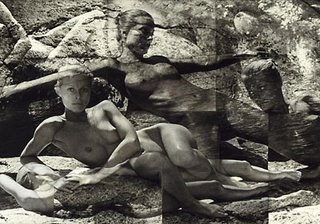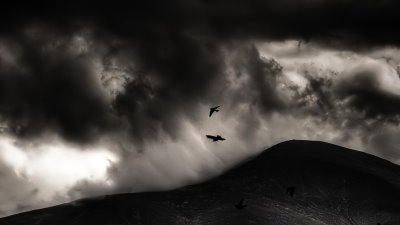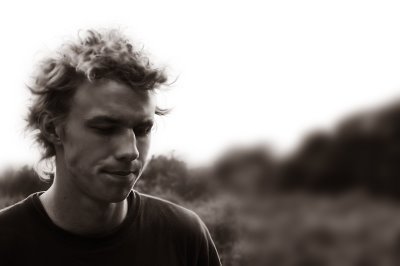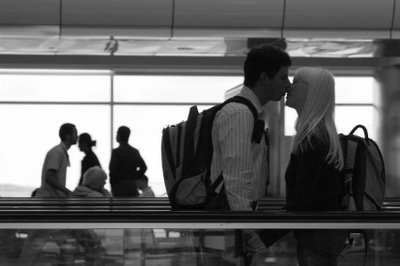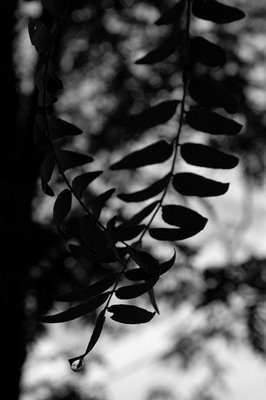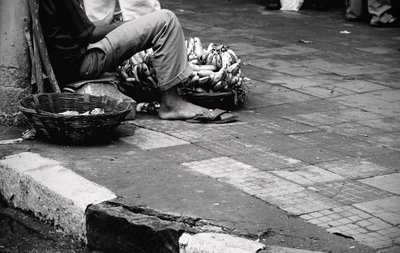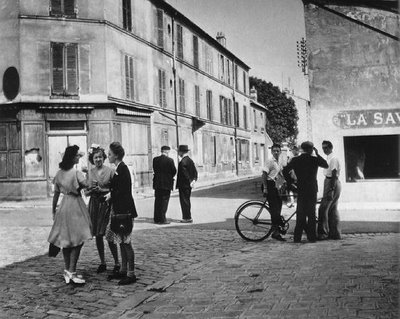I have to agree with Andy Frazer that this is one of the best side-by-side examples I've ever seen of pictures taken without and with flash.
Posted by: MIKE JOHNSTON thanks to Andy
|
simple is beautiful


The Online Photographer: October 2006
 2 ... 2 ... 2 ... 2 ... |
Blog Archive
|
Tuesday 31 October 2006Monday 30 October 2006Buy 'Em a Plane Ticket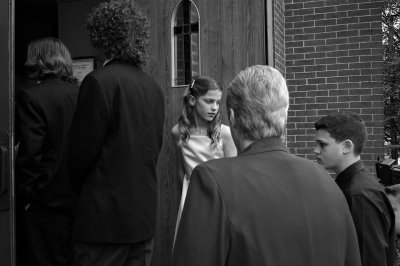 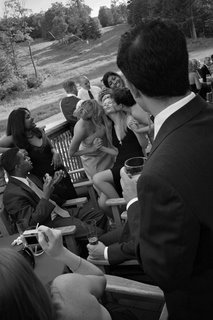 And speaking of Sean and Melissa Reid (Sean writes the pay camera-review site Reid Reviews, if you're coming late to the conversation), if I ever get married, that's who I'd hire. I like the "wedding photojournalism" name. And speaking of Sean and Melissa Reid (Sean writes the pay camera-review site Reid Reviews, if you're coming late to the conversation), if I ever get married, that's who I'd hire. I like the "wedding photojournalism" name.Wedding photographers in general are the Rodney Dangerfields of photography (the late R.D. was a comedian whose tagline was "I don't get no respect," if you're coming late to that conversation). Wedding photography is actually quite difficult, presenting the photographer with a wide variety of challenges and only one chance to get it right. One of the side effects of a career spent dispensing advice is that people often come to me for advice. (Oh well.) So every now and then someone says, can you recommend a good wedding photographer? There have been a few I've recommended over the years, including the late Susan Kennedy, in the Washington, D.C. area, who had a knack for putting brides at ease and adding a nice presence to the ceremony. But most of the time, regardless of who I recommend, and regardless of price they charge, the follow-up is the same: can't you recommend somebody cheaper? 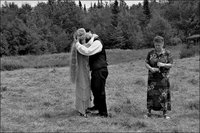 Well, heck. And then a third of the couples in America complain about their wedding photography. (One day I'm going to write a book called "Two Plus Two," about the many ways in which people overlook obvious explanations for things that are right in front of their noses—for instance, in the 1980s there were thousands of spooky, unexplained Elvis sightings. There were also 200 full- or part-time Elvis impersonators in America! Put two and two together, people....) So do you want cheap or do you want good? The two can be different things. Well, heck. And then a third of the couples in America complain about their wedding photography. (One day I'm going to write a book called "Two Plus Two," about the many ways in which people overlook obvious explanations for things that are right in front of their noses—for instance, in the 1980s there were thousands of spooky, unexplained Elvis sightings. There were also 200 full- or part-time Elvis impersonators in America! Put two and two together, people....) So do you want cheap or do you want good? The two can be different things.My advice if you want to hire a wedding photographer? Find one you really like and buy 'em a plane ticket. What's the added expense in the overall scheme of paying for a wedding? You don't get married every day. Here's a link to Sean and Melissa's wedding photography site. (I note in passing that most of their pictures look too dark on my monitor, which probably indicates a monitor calibration mismatch between their site and my monitor. Your mileage will probably vary.) Posted by: MIKE JOHNSTON Saturday 28 October 2006Photographing as a Subject for Photography The "No Comment" picture below reminded me of this great shot from Sean Reid's wedding photography website. Turns out this was taken by Sean's wife, Melissa Reid, who was on second camera for that particular wedding. Sometimes showing some of the many amateur photographers at work at such an event can add another dimension to documentary-name wedding work. (I have to admit I have a soft spot for photographs of photographers, well-known or anonymous, whether taking pictures or not.) The "No Comment" picture below reminded me of this great shot from Sean Reid's wedding photography website. Turns out this was taken by Sean's wife, Melissa Reid, who was on second camera for that particular wedding. Sometimes showing some of the many amateur photographers at work at such an event can add another dimension to documentary-name wedding work. (I have to admit I have a soft spot for photographs of photographers, well-known or anonymous, whether taking pictures or not.)Posted by: MIKE JOHNSTON Friday 27 October 2006Twelve Undervalued Photographersby Missy Sullivan, Forbes Collector Photography is one of the most steeply rising markets in the collecting world right now. In the New York spring photo auctions, the number of lots that sold for six figures rocketed from 25 last year to 85 this year. And auction records have been shattering at a neck-snapping pace. The world record for a 20th-century photograph hit $822,400 last October, rose to $1.2 million in November, then soared to $2.9 million three months later. Funny, that only 30 years ago, photography was the art market’s poor stepchild. Since then, more museums have built photographic collections. Scholars have identified the masters of the medium. Art dealers figured out how to successfully market multiples. Conservators have learned much more about materials, techniques and fakes. And as the history of the medium is fleshed out further, more work is being done to identify worthy, lesser-known artists.... READ ON Posted by: DAVID EMERICK
Joe Reifer
Joe Reifer, who occasionally contributes to T.O.P., has started his own blog, and you're invited to pay a visit.
Posted by: MIKE JOHNSTON Thursday 26 October 2006On Rain DelaysI asked Mike if he'd ever talked to Johnny Sain about contracts and he said he hadn't. Sain gives you good advice about how to get money out of a ballclub. John's a quiet guy and follows most of the baseball rules about keeping your mouth shut, but he's not afraid to ask for money if he thinks he deserves it. He was with the Boston Braves in 1948, the year they won the pennant. It was Spahn and Sain and then, dear Lord, two days of rain. Warren Spahn and Sain were the staff and Sain really put it to John Quinn, who was the general manager. Sain had had a big argument in the Spring about his contract and signed for less than he wanted. Now they were just home from a western trip and fighting for the pennant and Sain went to Quinn and said, "I'd like to talk about my contract." "We'll talk about your contract next winter, when it comes up," Quinn said. "No, I'd like to talk about it now," John said. "What the hell," Quinn said. "You signed a contract and we're going to stick by it. We can't renegotiate a contract during the season." "Well, we're going to renegotiate this one," John said. "What the hell do you mean by that?" Quinn said. "I'm supposed to pitch Thursday," Sain said. "But unless you pay me what I wanted in the beginning I'm not pitching." That meant it would be Spahn and rain and pray for a hurricane, and then maybe a flood. So Quinn tore up his contract and gave him a new one, and John won 24 games. He used to say to me, "Now, don't be afraid to climb those golden stairs. Go in there and get what you're worth." Those golden stairs. Wednesday 25 October 2006Eric Newby Alas, today is British obituary day at T.O.P.: Eric Newby has passed away. Though known primarily as a travel writer, he made wonderful pictures as well. His 1989 classic, What the Traveller Saw Alas, today is British obituary day at T.O.P.: Eric Newby has passed away. Though known primarily as a travel writer, he made wonderful pictures as well. His 1989 classic, What the Traveller SawPosted by: OREN GRAD Follow-Up by Mike J.: Ach, this is one of those that hurts. I found What the Traveller Saw in a used bookshop in Washington in the early '90s and felt, at the time, that I had made a great discovery, as though the book weren't a published work of art and manufacture but a wild resource I had discovered singlehandedly. I claimed it for myself like Aguirre planting a flag in a South American mountaintop. For a time, whenever somebody asked me the inevitable question "what kind of photographer are you?", I would answer by saying "I want to be Eric Newby." Which would have served indefinitely, if anyone in the art world—even the art-photography world—had ever heard of Eric Newby. The life of a travel writer is interesting in that it implies a prioritizing: travel first, writing second. (It might not actually be that way, of course.) With Newby, there was a distinct added clause: third, snappin' pics. But don't be fooled. Despite his "humble Pentax" and 50mm lens, he was a talented and committed photographer with a clean, honest way of looking at things (he tells a funny and slyly competitive story in What the Traveller Saw of getting a particular shot while a famous Kodachrome-and-Leica-weilding Magnum pro he was travelling with blew his exposure settings and missed the shot altogether). Not flashy, but organic in a way that a lot of photographers will never match. His work is plain in a good way. I think the thing I like best about What the Traveller Saw is that it both proposes and answers—well, answers one way, anyway—the question "what do you do with photography?" Newby answered with aplomb, humor, modesty, and, always, surpassing good grace. I never knew the guy, so I can't say "he will be missed." I just know his books, which I'll continue to treasure and enjoy.  What the Traveller Saw is sure to go out of print again before too long. Take my advice and nab a copy while you can. If it doesn't grab you right away, put it on the shelf. One day you'll make its charming acquaintance and be glad you did. What the Traveller Saw is sure to go out of print again before too long. Take my advice and nab a copy while you can. If it doesn't grab you right away, put it on the shelf. One day you'll make its charming acquaintance and be glad you did.
'Pictures Will Be Our Epitaph':
The Independent, October 25th, 2006
by Ben Felsenburg Denis Cameron, photographer: born Minneapolis, Minnesota 19 October 1928; twice married (one son, one daughter); died London 6 October 2006. No surprise that a photographer's life should range far and wide, but Denis Cameron was something else. Like a real-life Zelig, he seemed to pop up at every event of political and cultural significance for a few decades in the second half of the 20th century—except, unlike Woody Allen's character, Cameron was the one behind the camera. He photographed Hollywood stars and the war in Vietnam; his pictures were the common denominator of the Prague Spring, the fall of the Berlin Wall, Ayatollah Khomeini, Sophia Loren and Errol Flynn in a casket. He made his home in Los Angeles, Paris and London, but for a time more than anywhere Cameron belonged in South-East Asia. He loved Vietnam, Laos and Cambodia, the countries and their people; having initially been sent on assignment by Time and Newsweek for a couple of months in late 1969, he stayed for six years. The war was rolling across borders into an increasingly wide and bloody conflict, and Cameron's camera caught all aspects of the devastation: again and again he documented the suffering of children in the midst of war, but also he knew how to point a camera at a man with a gun and still find the humanity in a battle-weary face. There was dark humour in his reportage—"My God! How'd we get in this mess?" emblazoned on the door of a US helicopter gun-ship. Cameron was graced with a bloodless nerve that stood out even among the diehards of Vietnam.... READ ON Posted by: MIKE JOHNSTON, thanks to Tim Tuesday 24 October 2006Different Views from The Guardian from The GuardianWar, poverty and terrorism, or everyday intimate moments—the camera captures both global events and ordinary lives. Blake Morrison reflects on the history of 20th-century Europe as told in photographs. As a student, like other students of the era, I stuck photographs of war atrocities round my bed. There was one in particular, which I'd cut from the Sunday Times colour magazine, depicting the My Lai massacre in Vietnam, when US soldiers led by Lieutenant William Calley murdered hundreds of civilians: the photo showed a heap of bloody corpses lying in a ditch. The photos attracted odd looks from less political-minded peers and they didn't do much for my sex life. But though the piety and ghoulishness of having them there now embarrasses me, they weren't merely right-on, in the way a Che Guevara poster would have been. The display was an expression of astonishment that something like this could have happened in our time—out there in the killing fields, away from the sanctuary of the campus. We weren't witnesses, as the photographer had been, but this was history and we were living through it and no one must be allowed to forget.... READ ON Posted by DAVID EMERICK
Say 'Cheeseburger'
"He lifted the school-portrait camera from its rigid confines and moved it several feet closer." A brief meditation on life, death, and the ubiquity of tastelessness. (But isn't "Dorian" a male first name?)
Posted by: MIKE JOHNSTON Monday 23 October 2006Why We Don't Buy CDs
Okay, now this is completely off-topic and yes, literally whiney, but so completely true I just have to share it with you. See if the music-lover in you doesn't agree....
(Note: Don't open this link at work) Posted by: MIKE JOHNSTON thanks to David E. The Seductive Tyranny of Digital Printing
by Ctein
Writing 400-word columns is good discipline for me (to say I've a predilection for loquaciousness is criminal understatement) but the disadvantage is that nuances and complex discussions don't fit into 400 words. If this column seems in conflict with my last, consider Walt Whitman: Do I contradict myself? That said... Digital printing my color negatives eats up way too much of my time and money. I'm a very efficient wet darkroom printer. I can turn out a finished, color-balanced, dodged-and-burnt-in Ektacolor 8x10 in 20 minutes without breaking a sweat. I average 2.5 sheets per finished print, including proof sheets and test strips. Last week I ran through 100 sheets of Ektacolor paper at a total cost, including chemistry, of under $50. It takes me about two sheets of paper to get a finished inkjet print, but the materials cost me $1.20-$1.50 per sheet. I can do a finished photo on the computer in about 30 minutes but only if I avoid really getting into refining the print. Then it's 45–60 minutes. Doing those same 100 prints on the computer would have cost me $120–$150 and taken two to three times as long. You can see the biggest time problem is I spend way too much of it twiddling those bits. Digital printing gives me far more precise and complete control over the look of the print than darkroom printing does. At least, anything this side of dye transfer. I can refine the aesthetics of print on the computer vastly better than I ever can in an Ektacolor print.  An inkjet print. Much, much better... but at 3X the cost and time. Was it worth it in this case? I think so. Could I afford to do that for all my prints? No way! An inkjet print. Much, much better... but at 3X the cost and time. Was it worth it in this case? I think so. Could I afford to do that for all my prints? No way!This extra level of the aesthetic control I get on the computer is terribly hard to resist. When I look at the ability to control curve shapes, do precise local dodging and burning-in and color corrections, etc., I succumb. As a fine printer who really cares about how his prints look I can't stand making second-best prints. I get sucked into making all those refinements that I couldn't possibly make in an Ektacolor print. Because I can. But that isn't unalloyed joy! I mean, time and money are why I never printed everything as dye transfer prints. Similarly, if I only printed digitally I could afford neither the time nor the money to print most of my photographs. Computer-assisted printing is a true gift...but a gift is not always a blessing. Posted by: CTEIN
The Hot New Acronym: "DRF"Sean Reid has just published Part 2 of his Leica M8 review on the pay site Reid Reviews. This is at the moment probably the most comprehensive review of the new Leica "DRF" (digital rangefinder) on the web. Other articles at the site cover a smattering of the more expensive DSLRs and "boutique" rangefinder cameras and their lenses, along with some reflective opinion pieces about equipment. Posted by: MIKE JOHNSTON Saturday 21 October 2006Vive la France! ...From a review in French of the Canham 11x14 view camera. Posted by: MIKE JOHNSTON, hat tip to Struan Gray via O.G. Please
It's been a while since I've said this, so I might as well say it again: the rule for comments is no ad hominem. Comments making personal attacks toward anyone who might be likely to read it here will be rejected, regardless of how pertinent or thoughtful the rest of the comment might be.
We've received several informative comments recently which end with an unacceptable "parting shot." I have no ability to edit the comments; I can only moderate them—that is, say is "yes" or "no." One cheap shot disallows the entire comment. Posted by: MIKE JOHNSTON Thursday 19 October 2006'Mastering Landscape Photography'by Alain Briot I am pleased to announce the publication of my new book: Mastering Landscape Photography. Mastering Landscape Photography is a collection of my 14 Aesthetics and Photography essays, together with numerous photographs, many of them full-page. The essays have all been edited and revised by a professional editor and new full-page photographs have been added. The layout is also new and was done by a professional layout designer. The book is 8x11 inches with 280 pages. I have seen a pre-publication version of the book, and although I am quite picky when it comes to prints and publishing, I have to say that I was impressed by the quality of the layout and the printing. I will be offering signed copies on my website when the book is published in mid-November. These signed copies will come with a companion print of one of the photographs in the book. I can also dedicace your copy with a personal note if you ask. The first 40 orders will benefit from an exclusive special offer not available after the first 40 copies are sold. To give everyone an equal chance to benefit from this limited special offer, I have opened a pre-release email list. Joining this list is very simple: all you need to do is respond to this email with “Mastering Landsape Photography” in the subject line. My email is alain@beautiful-landscape.com. Just type “Mastering Landscape Photography" in the subject line. There is no obligation to buy. You will simply be added to the list. You will be first notified when the book is available and you will have a chance to be among the first 40 orders to benefit from the special offer. I have also created a page on my site where you can see the latest news about the book. For example, I plan to add a table of contents and sample chapter in PDF format soon: Thank you for your interest in my work. Posted by: ALAIN BRIOT
Debbie G.'s Photoshop Blog Popular Photography & Imaging magazine's Debbie Grossman (who, a few years ago, was the subject of a famous series of duelling makeovers when a reader complained about her unglamorous portrait in the mag) has a new Photoshop blog at Popphoto.com in which she answers reader questions on all things relating to Photoshop. The blog has a nice format in that you can scan the questions and only read the answers you're interested in. You don't need to be a subscriber to ask a question; just e-mail deardebbie@popphoto.com. Popular Photography & Imaging magazine's Debbie Grossman (who, a few years ago, was the subject of a famous series of duelling makeovers when a reader complained about her unglamorous portrait in the mag) has a new Photoshop blog at Popphoto.com in which she answers reader questions on all things relating to Photoshop. The blog has a nice format in that you can scan the questions and only read the answers you're interested in. You don't need to be a subscriber to ask a question; just e-mail deardebbie@popphoto.com.Posted by: MIKE JOHNSTON Still-Life Mentor to a Filmmaking Generation Jerome Liebling, Morning, Monessen, Pa. (1983). The filmmaker Ken Burns said Jerome Liebling, Morning, Monessen, Pa. (1983). The filmmaker Ken Burns saidMr. Liebling taught him that "all meaning accrues in duration." By Randy Kennedy, The New York Times For much of a half-century of taking quiet, subtly powerful pictures that demand and reward long looking, Jerome Liebling has been known as a photographer’s photographer. The label is both a high compliment and an acknowledgment that Mr. Liebling, now 82, has not enjoyed the acclaim accorded to many of his contemporaries who first took their cameras to the streets of New York after World War II. But a more fitting way to describe Mr. Liebling would be as a documentarian’s photographer. And judged by that standard, his work has rarely suffered from a lack of attention. In fact, spend any time watching the films of Ken Burns, or those of the legions of documentary makers he has inspired, and you will see Mr. Liebling’s work, in a sense, even if you have never laid eyes on one of his photographs.... READ ON Posted by DAVID EMERICK
Ferranti-Dege R.I.P.by Kent Phelan 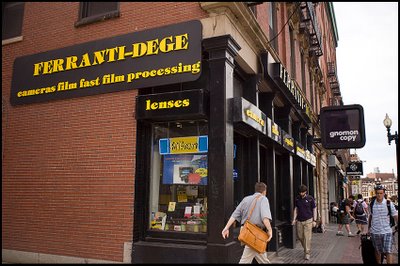 Got the sad news today that Ferranti-Dege in Cambridge, Mass. has closed its doors. It was a Harvard Square landmark for 51 years, operating on "Mass Ave" across the street from Harvard since 1955. Got the sad news today that Ferranti-Dege in Cambridge, Mass. has closed its doors. It was a Harvard Square landmark for 51 years, operating on "Mass Ave" across the street from Harvard since 1955.The closing came with little notice. Anthony Ferranti no doubt wanted little fanfare. His place had legions of fans, friends, students and customers. It was a beehive for photographers and budding photographers for decades. It was a Mecca for Boston area photo students, and was the stomping ground of the Tufts Photo Mafia. Many working pros today got their start there behind the counter, or working in the E6 or B&W labs, or from the constant flow of advice, opinions, dissent, and at times outright ranting from the staff. All at no charge. The original store at 1286 wasn’t big enough (believe me, it was huge), so they opened up Ferranti-Dege Too a block away at 1300. In their heyday, for a couple of decades, Ferranti-Dege was the center of the photographic community in greater Boston. Even walking down the street, you could smell the place. They put their black & white lab in the basement of F&D Too. Like all of the old Harvard Square buildings, the basement actually extended underneath the sidewalk of Mass. Ave. Ferranti’s had an exhaust fan that blew the air from the lab out onto the sidewalk. People walking by or gawking in the window would be greeted with the smell of fixer. This was not lost on photo students at the time. It was a different time and place, and in some ways represents the height of silver based photography. The audience created by F&D is enormous. There are too many working pros my dim memory can recall that frequented that place. Former alums Rick Mandelkorn, Max Belcher, and Mark Thayer. Constantine Manos was a Saturday morning regular, as were other Magnum photogs. Even Phil Levine would make it a point to peruse the windows at F&D Too (the little store, with the LF equipment). One of my fondest memories there was when we had an 11x14 Deardorff in the window. Someone had the presence of mind to position it towards the street and focus it on the passers-by in front of the window. I happened to be standing behind the counter when E.P. Levine happened along. He was dressed like JFK, with suit, cashmere overcoat and Fedora. I watched Phil do a double take, turn around, bend down and squint at the camera as he was obviously looking at the lens particulars—all upside down on the groundglass. Funny how you remember some things. Classic Cambridge, classic Boston, classic Phil, classic Ferranti’s. I am glad I got to spend some time there. Tony closed up shop for good on Friday, October 13, 2006. He and his troupe will be missed. Posted by: KENT PHELAN Harvard Crimson article about the end of Ferranti-Dege Burt Keppler on Megapixels
And Now We Are 10, Megapixels That Is
by Herbert Keppler It was just a few months ago DSLRs were 6, and now we are 10—Canon Rebel XTi, Nikon D80, Sony (then still Konica Minolta) Alpha 100, Pentax K10D and Olympus E-400 (not to be available in the U.S. for now). And we’re not yet done growing megapixels. Execs of the major camera manufacturers prophesy that as long as buyers go for more pixels as a major consideration in buying DSLRs particularly, the higher the count will grow. Canon, Nikon and Fuji, top pro DSLRs already, are over the 10 megapixel plateau. In practical terms, do amateur consumers really need more megapixels or is this megapixel increase primarily a marketing strategy to help you coax 6 megapixel owners to dump their cameras for 10? READ ON Posted by: MIKE JOHNSTON Apple Profit Rises 27%; Stock Jumps
By Laurie J. Flynn, The New York Times
October 19, 2006, SAN FRANCISCO — Apple Computer said Wednesday that strong sales of its Macintosh computers and iPod portable music players led to a 27 percent rise in its fiscal fourth-quarter profit. The results, released after the market closed, caused Apple’s shares to jump as much as 6 percent in late trading as the company surpassed Wall Street forecasts. [...] The company, which is based in Cupertino, Calif., reported net income of $546 million, or 62 cents a share, in the quarter, up from $430 million, or 50 cents a share, a year earlier. Revenue was $4.84 billion, an increase of nearly 32 percent from $3.68 billion the year before. [...] Macintosh sales accounted for 58 percent of revenue in the quarter, spurred in part by the new school season’s huge demand for notebook computers, the company said. In September, Apple expanded its line of Macs and completed a transition to Intel-based microprocessors. In a conference call with analysts, the chief financial officer, Peter Oppenheimer, spoke of "the best Mac shipments by far in any quarter in Apple’s history." The company said it shipped 1.6 million Macintosh computers, up 30 percent from a year earlier. Revenue from desktop and portable Macs increased 37 percent, to $2.2 billion. Apple’s chief executive, Steven P. Jobs, said: "This strong quarter caps an extraordinary year for Apple. Selling more than 39 million iPods and 5.3 million Macs while performing an incredibly complex architecture transition is something we are all very proud of." An analyst at Piper Jaffray, Eugene A. Munster, seemed to agree. "It’s an impressive quarter," he said. "They blew away even the highest expectations on the Mac side...." READ ON Posted by: MIKE JOHNSTON Tuesday 17 October 2006Perspective Correction in Photoshopby Max Hertelendy  Original OriginalThis picture was shot with a Canon 17mm lens on 35mm Velvia. There are plenty of corrections to be made, but I want only to show how a shot taken at an awkward-looking angle can be changed to appear in "normal" perspective again. If this can be done, I think there's a big advantage in using a very wide-angle lens to get everything you want into the picture (sometimes you don't have enough room, sometimes the horse you're riding on is too nervous and you get what you can) and then correcting back to a regular point of view. The original has the typical 35mm proportions. While the corrected version is almost square, it is much closer to the real proportions seen by the naked eye, and the mule and cactus poses are much closer to natural. This results from first enlarging your canvas size to get space to work with and then skewing the picture (like crazy and in every direction you feel like) to get the verticals, horizontals and parallels right and then rescaling vertically because after correcting angles the shot looks flattened. The key of the game is "make it look natural." The skew command is an option in the Photoshop Edit>Transform menu. Pulling the image corners modifies angular scale (use it to make lines parallel), and moving the middle points of the sides of the picture changes the angles. Better to try it—it's difficult to make a short explanation. This is far easier in terms of the picture not falling apart when resolution is higher (in this case, if you print big enough, the grain is clearly elongated), and when you don't crop too tight when shooting the original, because the skewing brings some of the corners in, and when you reframe and crop you lose some surrounding (I'd like some more foreground in this picture to work with). When done sensibly, especially in city landscapes, this makes a huge impact in perception; things look a lot more balanced and less nervous to me. This picture is quite extreme, mostly because the lens angle of view and the taking angle, but I think it works as an example. It's obviously a matter of tastes, but the results are very interesting. Posted by: MAX HERTELENDY Online Four-Thirds Lens Catalogue Olympus Imaging Corporation, Matsushita Electric Industrial Co., Ltd. and Sigma Corporation have jointly compiled a detailed catalogue of exchangeable lenses for their digital single-lens reflex camera systems based on the Four-Thirds standard. Supporting companies of Four-Thirds include Eastman Kodak Company, Fuji Photo Film Co., Ltd., Leica camera AG, Matsushita Electric Industrial Co., Ltd., Olympus Imaging Corp., Sanyo Electric Co., Ltd., and Sigma Corporation. Olympus Imaging Corporation, Matsushita Electric Industrial Co., Ltd. and Sigma Corporation have jointly compiled a detailed catalogue of exchangeable lenses for their digital single-lens reflex camera systems based on the Four-Thirds standard. Supporting companies of Four-Thirds include Eastman Kodak Company, Fuji Photo Film Co., Ltd., Leica camera AG, Matsushita Electric Industrial Co., Ltd., Olympus Imaging Corp., Sanyo Electric Co., Ltd., and Sigma Corporation."The core design concept of the Four Thirds system is to facilitate optimization of the size, performance, and extendibility of digital cameras and lenses. In addition, a standardized lens mount allows photographers to freely combine interchangeable lenses and cameras from different manufacturers. This is the key feature of the Four Thirds system, the one that makes it possible to explore the full potential of digital photography." Four-thirds.org catalog Posted by DAVID EMERICK
'People See It In Many Different Ways...'Photographer Danny Goldfield set out to photograph one child from every country on Earth all living in New York City. Posted by: MIKE JOHNSTON thanks to Bob B. Creating Beauty
I can't speak to the underlying company, product, organization or campaign, but this certainly is an eye-opening little mini-film (runs less than a minute).
Posted by: MIKE JOHNSTON thanks to Stanco Monday 16 October 2006Pentax K10 Samples Detail, K10 sample  Pentax UK has posted a number of sample JPEGs from the new K10 DSLR (the illustration at left was reduced in size and converted to sRGB before posting here, so go to the link before commenting). Meanwhile, in this thread on the Rangefinder Forum, a poster claiming to be the soul singer Seal says he's gotten a Leica M8 but won't publish images. Me? I'm married to Morgan Fairchild, who I've seen naked! Yeah, that's the ticket. We'll all be waiting around for those out-of-focus M8 snapshots of Heidi Klum. Pentax UK has posted a number of sample JPEGs from the new K10 DSLR (the illustration at left was reduced in size and converted to sRGB before posting here, so go to the link before commenting). Meanwhile, in this thread on the Rangefinder Forum, a poster claiming to be the soul singer Seal says he's gotten a Leica M8 but won't publish images. Me? I'm married to Morgan Fairchild, who I've seen naked! Yeah, that's the ticket. We'll all be waiting around for those out-of-focus M8 snapshots of Heidi Klum.Posted by: MIKE JOHNSTON thanks to KP UPDATE: Why do I always have to be wrong about stuff like this? Here's a link to some photos of Seal (sporting an M8) and Heidi Klum. Sunday 15 October 2006'Mine-Golia'Saturday 14 October 2006PHOTOBLOGGERS EXPOSED IV
Gavin Mullan, Gabriel Loeb, and Azhar Chougle
by Chantal Stone Smart, talented, and young Standing out among the many photographers out there can be a daunting task. Clear vision, unique perspective, and technical skill are all necessary, and, for many, can take years to develop. Here are three young men who have one factor that helps them to stand out: their age. At 16, 17 and 18 years old, these three photographers are already on their way to a successful career in photography. All three, although different from each other, possess the talent and drive to take them where they wish to go. 1. Gavin Mullan's dream of becoming a professional photographer seems within his grasp. In his second year studying photography at the Belfast Institute of Further and Higher Education, in Northern Ireland, this gifted 18-year-old photographer is building an impressive portfolio on his photoblog, Headphoneland. Growing up surrounded by art in his parents' gallery, Gavin was naturally drawn to all things creative. After a few art classes, Gavin felt the pull towards photography. He experimented with his mother's camera and was hooked. A friend introduced him to the world of photoblogging, and Gavin seized the opportunity. Not your typical Irish photoblog, there are no images of rolling green hills or rugged coastlines to be found here. Headphoneland is filled with sharp, often dark and stark images. Gavin's photographs reflect exploration—they are emotive, gritty, often moody and perhaps even at times oppressive. He has the ability to evoke reaction and spark an emotion from the viewer. "I think that's great the way one image can mean something completely different to each person. I never really thought that any of my photographs could make someone feel a certain way about them…Maybe the subject choices I make come from somewhere I haven't found yet, and that really excites me." 2. In a small middle school art class in Ann Arbor Michigan about five years ago, a teacher brought his students into a small room with one light hanging from the ceiling, and a swivel door. For three weeks, they were taught the fine art of pinhole photography. In Gabriel Loeb, an 8th grader at the time, a photographer was born. "The idea that you could take a cookie tin, stab a hole in it, and put a piece of paper in; and then come back in 30 seconds, toss it in some chemicals, and have a picture was amazing to me." Now 17 and a senior in high school, Gabriel's fascination with photography has grown considerably. After a few years of studying film photography, Gabriel has moved on to digital. His photographs, which reflect both his youth and innocence but also a trained eye with fine technical acumen, can be found on his photoblog, Simply an Idea. Gabriel's images echo a mature sensitivity, and are often intimate and thoughtful. From delicate nature close-ups to soft abstracts and quiet moments, Gabriel's photographs reflect the introspective side of this outgoing teenager who enjoys hanging out with friends on the weekends as much as he does searching for his next picture. From his photoblog, he writes: "Photography does not seek to replicate reality. It gives those willing to accept it a distinctly different view, even if it's just from another angle." Although he may not pursue photography professionally, with an ambitious course load in school and college just around the corner, the future is at hand for Gabriel. 3. Photography may be a new venture for 16-year-old Azhar Chougle, but this young man from Mumbai, India has tenacity and ambition that guarantees success in anything he pursues. In addition to being a burgeoning photographer, Azhar is an A student, an entrepreneur, a web designer...and a photoblogger. His work can be found at The Daily Sunrise. Azhar began shooting just this year in March, and since then has taught himself some of the ins and outs of digital photography and Photoshop. His images are very often arty and experimental, and energetic. Azhar shoots architecture, everyday life in India, and of course, the sunrise from his window. Azhar describes himself as "one who just likes to challenge himself every time, and do it better than others…[I] also happen to be reputed as a strange boy walking around my area with a camera too big for his age." Maybe not strange, but he is definitely unusual. Although quite young, Azhar uses his youth as an advantage in his pursuits, a way to stand out. In addition to designing his own site, he has also designed his school's website, and has built a hub for all of his projects at The Daily Network. Azhar dreams of a future in web design or photography. With drive and ambition like his, I think Azhar is sure to be a success. Posted by CHANTAL STONE Previous posts in Chantal Stone's Photobloggers Exposed series: I: Daniel Seguin, David Desjardins, Dean Sherwood II: Christian Wagner III: Leeroy Gribbon, Dimitrios Pananakis, Emma Townsend Mike Chaney's Color Management Podcast
The tech-heavy 22nd episode of The Digital Photography Show featured Mike Chaney, creator of Qimage and Profile Prism and the author of "Tech Corner" on Steves-Digicams.com. They had him on at the recommendation of listener Landya, who wrote “He is someone I really admire in the field of digital photography, printing especially. I own his printing program and it is fabulous. He is considered a God by those who use his program.”
Mike also did a podcast about color management that you can download at the link. To quote The Digital Photography Show, "Mike turned out to be an interesting guy who has that knack for explaining technical things in language that even a semi-simpleton...can understand." Posted by: MIKE JOHNSTON Thursday 12 October 2006Who's in Charge? You or the Camera?
by Ctein
I've observed a tendency for digital photographers to just take what their cameras hand them. Folks put up on-line galleries of their digital photographs for comment, critique, and simple enjoyment, but it's rare for those photographs to be anything different from what they downloaded from the camera. These folks are unconsciously operating much the same way slide film photographers did (more correctly, were forced to). Unless they are intentionally trying to present the world entirely as the camera saw it, this is a profound artistic mistake. Those of you who did wet darkroom printing before you took up digital photography should recall how you approached printing negatives. When you would go to print a negative, you'd instinctively view it as the starting point for a finished photograph, not as the final word. You'd make a test print and mull it over. You'd decide if you liked the cropping and composition, the contrast, the lightness/darkness, and whether you needed to do any dodging or burning in (the latter you might not be able to determine until you had nailed down the other qualities). It's the mindset that's important here; you never assumed that the negative handed you a finished print; it was up to you to figure out what the photograph should look like. (Those four basic characteristics, by the way, are good ones to think about with digital photographs, too. At least, the cropping and composition and the overall contrast and brightness. Even the simplest image-handling programs will let you manipulate those.) You'd see the converse of this when photographers printed slides in the darkroom. Many folks produced much worse (in the artistic sense) prints from slides than they would from a negative. Because the slide already handed them a viewable photograph, they unconsciously fell into the mental trap of accepting the slide instead of treating it as the starting point for making a really good image. Too many digital photographers fall into this trap. What they need to do is start to train themselves to see that fresh-from-the-camera digital photograph that looks 'pretty good' as nothing more than the beginning of a satisfying photograph, not the end result. Think of it as you would a negative, not a slide, no matter that it looks like one. Don't let those bits push you around; you're supposed to push them around! Posted by CTEIN
Three + Three
If each of us is being honest, and sensitive, I think we react to art in many ways much the same as we react to personalities. Some people we like, some people we don't. We might have friends we just met and hardly know but who are friends all the same, and people in our lives who remain strangers despite years of acquaintance. Some people we're attracted to, most we're not. Why? The standard shorthand answer is "chemistry." Good enough—'twill serve.
I know I react that way to sounds—voices and instruments. There are singers' voices I just love (Bob Marley, John Lennon) and others I can't stand (Whitney Houston, for me—nothing against Whitney personally, but I would almost rather be water-boarded than have to listen to "I Will Always Love You" three times. And I fear drowning). Probably each of us is the same way, albeit always with different people and voices and instruments. If you like pop music, try to think of three singers whose voices just reliably send you (sorry, a little Sam Cooke sublimination there) and three you hate regardless of how "good" you know they are. 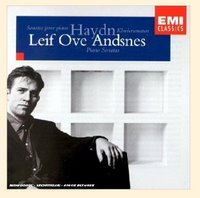 The instrument I most reliably love is the piano. Don't know why, just do...it's that "personality" thing I guess. Leif Ove Andsnes is my favorite pianist these days (try this The instrument I most reliably love is the piano. Don't know why, just do...it's that "personality" thing I guess. Leif Ove Andsnes is my favorite pianist these days (try thisSo here's a question. I'm going to try not to load this up with value judgments, try not to make it a challenge or a goad. But are there three photographers whose work meshes with your personality in that way I'm talking about? And three whose work you just can't stand, maybe even for no good reason? Just something to think about. In fact, I think I'll put on some Andsnes and go think about it myself—I'll get back to you. Posted by: MIKE JOHNSTON Wednesday 11 October 2006When Is an Action Photo a Still Life?Why are all those tourists ogling that well-dressed, happy-go-lucky Italian businessman/commuter on the go? Because he's actually standing perfectly still, precariously balanced perhaps, but perfectly motionless nonetheless—hardly what the image implies. Complete with "windswept" hair and wired tie and jacket to mimic speed and motion, and carefully choreographed stop-action footwork—this guy has definitely done his homework and knows full well how photography depicts the human body mid-stride! Posted by: STAN BANOS
Tuesday 10 October 2006Articles of the Real and the Virtual Thomas Eisner, untitled color photocopy, from "Eye Catching Images of Nature, Made With a Common Machine" "Eye-Catching Images of Nature, Made With A Common Machine" by James Gorman, from the New York Times. "The Treacherous Medium: Why photography critics hate photographs," by Susie Linfield, from Boston Review "Peeking Under the Cover," by Richard Bryne, from the Chronicle of Higher Education "Virtual Reality or Real Virtuality?" by David Strom, from TidBits Posted by: MIKE JOHNSTON with thanks to several T.O.P. secret informants Monday 9 October 2006J. Buhler's Day Off Every now and then I just have to post a particularly great shot from Water Molotov. Look at this one for a minute—just look at it. That's from life; you can't make stuff like that up. I admit the tones seem all wrong to me, but man, if you don't like this, I don't know how you could still say you like photography. Posted by: MIKE JOHNSTON Victoria Crater and 'Opportunity' This spectacular, serenely beautiful photograph, compliments of the HiRISE high resolution camera on board the Mars Reconnaissance Orbiter spacecraft, shows Victoria Crater, an impact crater at Meridiani Planum, near the equator of Mars. The crater is approximately half a mile (800m) across. This spectacular, serenely beautiful photograph, compliments of the HiRISE high resolution camera on board the Mars Reconnaissance Orbiter spacecraft, shows Victoria Crater, an impact crater at Meridiani Planum, near the equator of Mars. The crater is approximately half a mile (800m) across.Even more amazing is that the Mars Exploration Rover, "Opportunity," has been exploring Victoria Crater, and can actually be seen (along with some of its tracks) in the photograph (remember, it's taken from orbit). Check out Bad Astronomy for more, including links to the closeup pictures showing the rover. This is unrelated, but, apropos of astronomy, I learned recently that our Sun and solar system are hurtling through space at some 43,000 mph, and that the direction it's heading is known by the pleasingly poetic term "the Apex of the Sun's Way." This phenomena was first described by astronomer William Herschel, whose son John, coincidentally, was the scientist who discovered that "hyposulfite of soda"—fixer—removed unexposed silver halides from emulsions, the last crucial puzzle piece in the process of making photographs permanent. Posted by: MIKE JOHNSTON with thanks to Will S. Sunday 8 October 2006A Little Higher Fidelity in Those Product Shots
I just uploaded a fairly long addendum to the PrimaLuna post. I was just about to add a picture of the Music Hall MMF 2.1, but I got put off by the low quality of the photograph. So, just for fun, I downloaded the shot from the importer's website and did a couple of quick corrections.
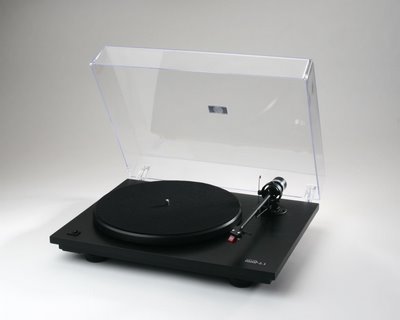 Here's the importer's JPEG (above)... 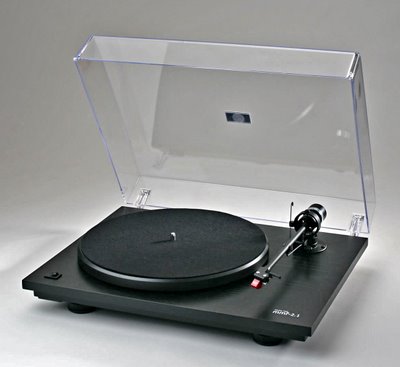 ...And here's my quick fix. Better? There is a lot more that could be done, and the shot itself could have been lit better. But at least you can see the product more clearly. It does bring up an interesting point. When I used to teach darkroom printing, one of the primary points I would always try to make is that skill is not so much knowing how to effect changes, but knowing what changes to make. The controls available in the darkroom are really fairly rudimentary; it's knowing when you need what that counts. If anything, this aphorism is more important now by a hundredfold. Granted, we all know how to apply a myriad corrections to our pictures, and the range of interpretation is far greater than it used to be. But even so, the most important thing to know is what the picture needs, pictorially or visually—not just how to apply the changes, but knowing what the changes should be. (If you want to try your own hand at improving the top JPEG, I'll be happy post your version too.) Posted by: MIKE JOHNSTON Tony Rowlett [see comments] might like this version better (click on the images to see them larger): 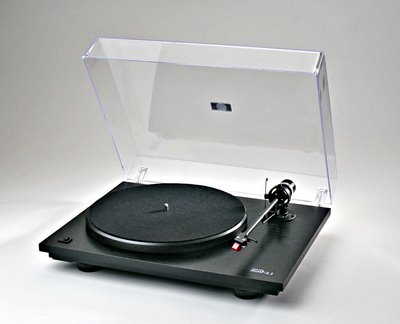
RSS Issues
Sorry if people are experiencing problems, but, for the record, I know nothing at all about RSS or any issues pertaining to it, except that people write to me to complain about it all the time. I have no idea how to set it, change it, implement it, cancel it, nothing. As far as I know Blogger uses Atom.
Sorry for being so clueless but I'm not a computer guy. Posted by: MIKE JOHNSTON Saturday 7 October 2006Patriotic B&J Seen on eBay: this Burke & James with a unique color scheme (they were made in America, too—Chicago, to be exact). Posted by: MIKE JOHNSTON with thanks to Oren T.O.P. Endorses: PRIMALUNA PROLOGUE ONE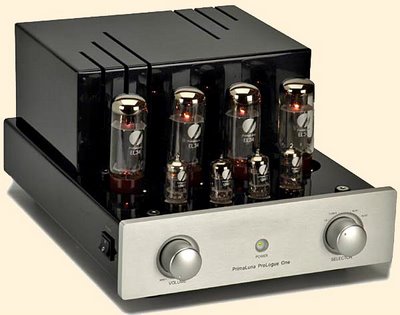 Right, it's not a photographic product, but you can leave it to me to deal with the splattering of e-mails I'll get informing me that the senders a) don't want my opinion on matters non-photographic, b) don't think I can write effectively about matters non-photographic, c) object to non-photographic articles from T.O.P. on their RSS feeds, blah, blah, blah. (I'll just reject and delete them all! MuAAAAhahahaha!) Right, it's not a photographic product, but you can leave it to me to deal with the splattering of e-mails I'll get informing me that the senders a) don't want my opinion on matters non-photographic, b) don't think I can write effectively about matters non-photographic, c) object to non-photographic articles from T.O.P. on their RSS feeds, blah, blah, blah. (I'll just reject and delete them all! MuAAAAhahahaha!)The best things in life are free, it's said. Such as, say, getting clean with your squeeze, watching your children grow, a long walk on a spectacular Fall day, taking in a sunset while sniffing a rose (which would make me sneeze, but never mind)—that sort of thing. And of course we all have our own preferences. Pleasure for you might be spotting a rare teal-tipped warbeldehoo on a hike in the rain forests of Brazil, or feeling the endorphins let go at mile 20 of a marathon, or re-reading Hume. (Personally, I wish I spoke another language so I could read Hume in translation; for some reason I have real trouble understanding him in English.) On the list of life's mundane or quotidian pleasures, those that are material are thought to exist on a lower level: a bottle of your favorite libation, a shopping expedition with a recently fattened credit card, an "endless" evening of Texas hold-'em. Doubtless, all of us who tend toward connoisseurship have our own custom-tailored short lists of the material pleasures we favor, too. For me, those include small, light, naturally-aspirated four-cylinder cars with manual transmissions, watching a black-and-white print (sorry, but yes) come up in the developer tray, books, and wierd, wonderful music late at night on a tube amp, at low volume. I don't actually own a tube amp myself at the moment, and I don't actually recommend a tube amp as your only source of power for music. The crackling rhythmic propulsion and crisper bass of a small British transistor amp generally better serves the '50s jazz I've favored for the past half-dozen years or so (thanks, Scott). (I also decidedly prefer acoustic-suspension speakers, which are essentially not made any more. Most people just plain can't hear bass.) And throughout most of their history, the care and feeding of tube amps has been something akin to keeping a vintage Indian or Triumph running—you know, a process thing. (Ahem.) Not to mention that the little brutes have traditionally represented very poor value for the dollar, euro, or pound. But those drawbacks have diminished, thanks to the world's newfound relationship with the emerging capitalism of red China. At this historical moment you can buy modernized replicas of classic tube circuits in splendidly solid casework for half to a third of what they go for when they aren't being put together by recently re-energized segments of the Chinese peasantry. Among several available choices, PrimaLuna is first amongst equals. The little ProLogue One, in particular, is both a great little tube amp (which not all cheap tube amps are) and a very inexpensive tube amp (which very few good tube amps are). Inevitable reviewer blather to the contrary, you'll have to choose your speakers carefully; something "tube friendly" (meaning approximately 90dB sensitivity and no less than 6 ohms impedance in the lower frequencies) is indicated. The sound of tubes is simply glorious, pure, caressing, and uniquely alive; if I didn't know better I'd say it's as good for shedding stress as a back massage. It attenuates you, lifts you up and draws you in. Especially at lower levels, where transistor amps have trouble not sounding dead, distant, and mechanical, tubes let music bloom and breathe. Unless you're one of those sorry souls consumed by your own mongering after status, in which case I have pity for you but no sympathy, you really don't need more than the little model One. I don't even think it should be your only amp—just an option you should have to switch into your setup when you feel like it. In fact, there is really no justification for owning a tube amp at all...except, of course, for the fact that music reproduced with one in the wee hours of the night is a material pleasure par excellence, one of the good life's little treats. Posted by: MIKE JOHNSTON Featured Comment by Mike Potter: Thanks for the post, Mike - I hadn't thought about tube amps in years. But don't leave us hangin'... :-) Now that T.O.P. has endorsed an integrated amp, what about a tuner and CD player to feed it, and speakers for it to drive? PrimLuna sounds like a pretty spiffy amp, particularly for the money. Mike replies: For a source, I would warmly recommend this, which can be purchased here among (no doubt) other places, and fed from here. Despite being way too cheap for any sort of respect from "audiophools," it's really quite lively and musical and will give a lot of pleasure. Speakers are quite another matter, as they all tend to do a few things right and many things wrong, and what one person finds charming will leave another cold. I would say I like about one out of every 50 pairs of speakers I hear, and that's knowing my own tastes, and what technical properties correlate to my tastes, quite well. The one thing I can say is that a speaker will sound better with the PrimaLuna if it is easier to drive (sort of analogous to that 1.8 liter 16-valve DOHC Toyota engine coming to life in the Lotus Elise whereas it's downright pedestrian in the much heavier cars Toyota puts it in). What you look for are two specs in particular—sensitivity, which will usually be given in decibels per watt at one meter (dB/w/m, although the notation isn't standardized as far as I can tell), and impedance. Generally speaking, a change of +/ 3 decibels in the sensitivity rating will correspond to a doubling or halving of amplifier power. Take a look at the specs for this speaker just as an example. It's rated at 91 dB/w/m, and the PrimaLuna is rated at 35 watts per channel. To get the same loudness with a speaker rated at 88 dB/w/m would require 70 wpc, and if your speaker has a sensitivity of 85 dB/w/m you would need 140 wpc. (This is why you can see very low-powered SET amps happily making music—they're paired, necessarily, with very high-sensitivity speakers, usually horns. A 5-wpc SET amp paired with a 106-dB/w/m speaker would have the same ability to play loudly as a 160-wpc amp and the 91-dB/w/m speaker linked above.) Complicating all this is the fact that power ratings and sensitivities are measured variously in non-standardized ways, and that other factors come into play in all specific amp/speaker pairings. But sensitivity is a good general indication of driveability. The other is impedance. A tube amp likes to see a benign load , so look for a speaker with an impedance of 8 ohms. The problem here is that there's no such thing as an "8-ohm speaker" despite the sale lit—the load varies with frequency, and every plot of impedance looks like waves, with highs and lows. So what you want to see is a plot that doesn't dip below, say, 6 ohms in the lower frequencies (the left-hand side of the plot). 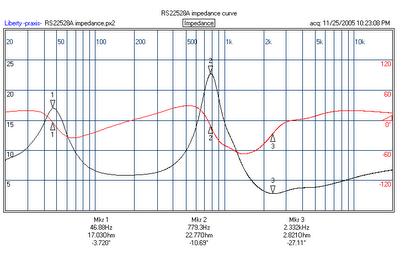 In the above plot, for example, note that the impedance dips way down (to 2.8 or so)...but only in the higher frequencies (around 2.2kHz). This particular speaker couldn't honestly be called an 8-ohm speaker, and yet it would be an easier load for an amp than many speakers advertised as 8-ohm that dipped to 5 ohms or less at 50 Hz or below. In the above plot, for example, note that the impedance dips way down (to 2.8 or so)...but only in the higher frequencies (around 2.2kHz). This particular speaker couldn't honestly be called an 8-ohm speaker, and yet it would be an easier load for an amp than many speakers advertised as 8-ohm that dipped to 5 ohms or less at 50 Hz or below.An appropriate speaker for a medium-powered push-pull tube amp would have a sensitivity above 90 dB/w/m and an impedance that never drops below 6 ohms, and not below 8 ohms in the lowest frequencies. And, of course, you would have to like the way it sounds (g) Friday 6 October 2006High Dynamic Range Imaging and Tone MappingUwe Steinmuller has posted an interesting basic review of Photomatix 2.3 by Multi Media Photo at Outback Photo. (Note that a quick glance at a number of examples indicates that this is a technique that's easily overcoked—but also potentially valuable.) The upgrade from any 2.X version is free. Posted by: MIKE JOHNSTON Featured Comment by Impasse Lebouis: Here's an alternative method to dynamic range increase. Ctein: Pentax 67 300mm* ƒ/4 ED(IF) Lens Review*450mm-equivalent on the Pentax K10D and other K-mount DSLRs. by Ctein  This spectacular photograph of fresh, red-hot pahoehoe lava shows off the 300mm ED(IF) lens at its best. Ctein was less than four meters from this flow, much closer than the older 300mm lens could focus. The original Pentax 67 300mm ƒ/4 lens is a 35-year-old design. It combined high speed and compactness with good optical performance for 1970, but its contrast is low by today's standards. It has a lot of secondary chromatic aberration, and doesn't focus very closely. Today's Pentax 67 300mm ƒ/4 ED(IF) fixes both problems. It incorporates extra-low dispersion (ED) elements that eliminate all traces of color fringing . Internal focusing (IF) goes down to a remarkable 2 meters, over 1/6X magnification. Even at the closest distance the image quality is superb; I could just barely see the very slightest amount of smearing, but no color fringing, at the edges of 11x14" prints.  The old (left) Pentax 300mm ƒ/4 lens and new (right) 300mm ED(IF) ƒ/4 lens. Note the narrow depth of field scale on the new lens. The focusing ring turns smoothly with very little effort. That's a good thing, because focusing is much more finicky, and I found it very difficult to accurately focus the new lens. The focusing ring on the old 300 mm lens has +/– 2.5mm of travel within the depth of focus at ƒ/4. The new ED(IF) lens has only 0.6 mm of travel. Partly this is an inevitable consequence of the much longer focusing range; partly it's because the total travel of the focusing ring on the new lens is only 225 degrees, as opposed to 270 degrees on the old lens. That's my only serious complaint about this lens. Its image quality is vastly superior to the old design. Even with difficulty focusing, my photographs were crisper and sharper over the entire field than I'd ever gotten before.  These are enlargements of 3mm-wide regions at the edges of negatives made with the old 300mm (left) and the new 300mm ED(IF) (right) lenses. Note the pronounced red-green color fringing produced by the old lens. Close focusing was indispensable on my last trip to Hawaii. I was able to photograph molten lava from safe distances but close enough to fill frames with exactly the compositions I wanted. There is no way I could have photographed the lead ilustration above with my older 300mm lens. I was less than 4 meters from the lava (and, yes, it was very hot, thank you for asking), much closer than I could've gotten with the old 300mm. Even if I'd used extension tubes with the old lens, chromatic aberration would've smeared out the myriad pinpoint highlights at the periphery into distracting little rainbows and obscured the fine detail. The new 300mm lens is just a bit larger and heavier than the original. It still takes 77mm filters but unfortunately lacks the built-in lens hood of the original. It comes with a soft storage pouch instead of the old-fashioned hard case. The pouch compresses nicely when empty, definitely more convenient for carrying around. I have to trust it offers sufficient protection. Another superior Pentax lens. I'm saving my pennies for this one, too (like the previously-reviewed macro lenses). Posted by CTEIN
Subscribe to:
Posts (Atom)
|
|
